Other than deciding to travel once I retired, my only other goal in life was to wear flip-flops twelve months of the year. It is now 11½ years and I have pretty well succeeded. The only other shoes I travel with are some low-cut XCR Gortex hiking shoes. I wear them in snow, when it is too cold or I am on a long trek. Flip-flops work for everything else, including dress shoes.
I need FFs that allow me to hike or walk all day. I have walked from Christchurch over to Littleton and back in flip-flops. I did every hike in my recent trip down the Grand Canyon in FFs. And many other times, I took flip-flop hiking to its limit. My coldest experience was easily a day in early April in Kyoto Japan where I walked the entire eastern side of the city. Basically the only time I don’t wear them is in the snow and if trekking where providing maximum protection for my feet is vital.
Non-FF wearers commonly state that they want something that protects their toes. But I always stub the front of my FF sole before anything damages my toes. Lack of protection from stubbing has never been a concern. Getting stepped on though is a different matter. China with its lack of social awareness scores high on this scale. With good quality flip-flops and some minimal breaking in, flip-flops are better for your feet and suffer few disadvantages.
ADVANTAGES OF FLIP-FLOPS
1. Breathability. I have hot, sweaty feet. They only really feel their best completely uncovered.
2. Cost. This saves on a whole lot of socks. And other shoes. Good FFs, though are not cheap.
3. Exercise for the foot. Wearing flexible sole shoes that often require gripping with your toes is good for the foot. This is only for FFs with good quality contour foot beds.
4. Fewer wear spots. Many people have “walking sandals” with straps behind the heel and a multitude of straps or laces to tighten them. But for me, these have way too many points of contact – any one of which can cause a hot spot or blister. I have to wear socks in sandals if I’m going a long distance. But FFs only contact at the toe strap and the wide side straps rarely produce hot spots.
DISADVANTAGES OF FLIP-FLOPS
1. Danger to your toes and foot.
2. Chronic callus on heels that cracks. This can be unbearable and I find is inevitable with constant use. Over the years, I carried a pumice stone, but it is a slow, inefficient way to control the problem. Recently I found the ideal solution – a microplane zester – a kind of food grater with flat cutting edges. You may smile, but try it first. It removes callus quickly and painlessly. I like the one by Microplane – 31cm X 3.4 cm with no handle. It is at least twice as long as I need, but with no handle, it can be used in both directions that is quite useful. As it is very thin, I takes up virtually no room in my pack.
3. Liability to damage to the footwear. Compared to other footwear, FFs are more vulnerable to damage. The toe loop is most liable to break or better yet, pull out in one piece, especially if you catch the toe of the FF and it is bent down with force. Rarely have I pulled out the side straps.
4. Blisters/wear areas between toes or under straps. Because of the small areas of contact, these can be a problem. Make sure the toe strap is of supple material. The best straps are simple webbing. I recently bought some Reefs with a pillowy material under the straps that collected sand. I eventually had to put on the hiking shoes.
5. Can’t easily wear socks (except ones with a split between the toes). This is most relevant when it is cold or to help hot spots once developed.
IMPROTANT PURCHASE FACTORS
1. Contour foot bed. This adds considerably to the cost. It is rare to find good ones under $60. If wearing FFs full time, this is mandatory if you do any amount of walking. The sole is of better quality on high-end FFs and the bed more supportive.
2. Foot bed material that doesn’t absorb odours.
3. Foot bed that doesn’t get slippery when it is sweaty.
4. Repairability on the road. Tearing out the toe or side strap is inevitable. If not repairable, simply throw them away – the flip-flips you can buy most any where will not be up to standard. But some FFs can be repaired anywhere. The best guys are the shoe repairmen with their little stands sitting on the street throughout third world countries.
5. Comfortable toe strap.
6. Main straps that don’t collect material like sand under them.
REVIEWS of FLIP-FLOPS I HAVE WORN RECENTLY
Appreciate that the brands listed below have different models with different features.
Reef. They are comfortable and nice feeling flIps. The heel breaks in and has some give for a softer feel than most. I don’t drink so don’t have much use for the bottle opener in the sole, but that could be a selling point for some.
Negatives.
a. The pair I have has a pillowed material under the side straps. I recently rafted the Grand Canyon and love to hike in flip-flops. But in sandy soil, I soon got sand under the straps that could only be removed in water with some rubbing. I eventually developed abrasions under the straps and had to hike in my hiking shoes.
b. The sole material absorbs odor. It helps some to wash them, but not for long. I don’t want to need a special odor killing cleaner while I travel.
c. The sole was a little too flexible and offered less support than desired.
Olukae. After 12 months of pretty happy use, a toe strap tore – right at where it enters the sole, and could not be repaired. Even though the warranty was just up, I was a given a store credit for the $77 flops. This is another advantage of buying good quality products – they have a warranty that the companies honour.
Negatives
a. Lack of repairability. This makes them incompatible with my travel.
b. When sweating, the sole gets slippery. It was necessary to wash them regularly to control.
Havaianas. Possibly the most popular FF brand and what I used when I threw away my Olukaes.
Advantages
1. They are much more available compared to the deluxe brands.
2. Relatively inexpensive.
3. Compared to cheap FFs, they have a good contour foot bed and a thicker cushioning sole.
Disadvantages
1. But these are not FFs you want to wear all day and walk long distances. The hard rubber toe piece inevitably will cause blisters, as may the firm rubber side straps. On my recent 5-month trip in west Africa, all those with Havaianas fought chronic sores between their toes.
2. Once the toe or side straps tear out, they become throwaways.
Chacos (I prefer the Ecotread model)
When I first started traveling, I wore Chacos for at least 8 years of constant wear – that was at least 4 or 5 pairs. But the Chaco flip-flops have recently become unavailable in Canada. What do they have against us? Everyone else seems to like Canadians.
So I bought Olukaes, Havaianas, and then Reefs. All the guides and boatmen on my recent rafting trip in the Grand Canyon wore Chacos. And these guys live in their flip-flops. They hike everywhere in them. That’s because they are the best. After arriving back in Flagstaff after my trip, I went to a few stores but none had size 11s. On my 2800km drive home, I stopped when I could, but it was end of season, and there was no selection. I ordered some Chacos online from the states.
I like Chacos so much, I have other styles – a pair with an all leather upper that I don’t like (heavy and the toe strap is hard leather) and a pair with a canvas upper like a shoe with a strap (I love these, they have a funky style and they are my favourite travel shoes when I need to wear socks. I also use them as wading shoes)
Advantages
1. Contour, anatomical foot bed. I have always found Chacos hugely comfortable and can walk long distances, all day in them.
2. Foot bed made of hard rubber – doesn’t get slippery and doesn’t absorb odours.
3. Toe strap always comfortable with minimal wear-in period.
4. Side straps are made of simple webbing that doesn’t hold grit or sand.
5. Field repairability. I have torn out the toe strap several times and a side strap a few times in my travels. I marvelled at the ingenuity of the guys on the street in India or Malaysia or the sophisticated guy in Taiwan. But as the entire strap comes out, and the sole is in two layers, it is easy to force the strap back with a screw driver and sew it in place to make them stronger than ever.
Disadvantages
1. Not widely available, especially in Canada. Fall selection often poor. There are a lot of guys out there with size 11 feet.
2. Expensive especially with present Canadian dollar exchange rates.
3. I inevitably rip out the toe strap or occasionally one of the side straps. I wish the manufacturer would secure the end of the straps permanently.
Have I convinced you yet?
HOW TO BUY CHACO ECOTREAD FLIP FLOPS IN CANADA
The only place to by then in Canada is via amazon.ca where the price was $170 CAD. Chaco and other companies do not ship to Canada. E-bay has them but you have to find your size, most are used, and shipping must be factored in. With retail, the cost is uniformly about $65 US. It is difficult, especially in September when I bought mine, to find much of a selection of styles or sizes. The only style generally available was black and I preferred one with a pattern. Size 11 was the most frequent size not available.
The solution is to use REI. They are reliable, ship to Canada and give rebates. They also have a Chaco flip flop sale (the only company that does this) in late summer. I don’t know when it starts, but I was able to buy exactly what I wanted for $31.83 US/pair. I bought 2 pair. The shipping was the same whether it was one or four pair. The only shipping available from REI internationally is by a courier (duty and shipping needs to paid separately on arrival). So mine arrive with the following fees: duty 12.71, GST 11.06, Processing fee 10.50, transaction fee 4.25 — total 39.26 CAD. The eventual final price including exchange, duty and taxes was $75.85 CAD, quite a good deal (actually less than new in US$).
I also bought 2 pairs from Moose Jaw, another US online company. Final cost $105CAD.
=============================================================
HIKING SANDALS – BEDROCK CAIRN SANDALS REVIEW
This review of the Bedrock Cairn Sandals examines footwear for hiking in sandals that is comfortable, secure, and grippy in dry, loose conditions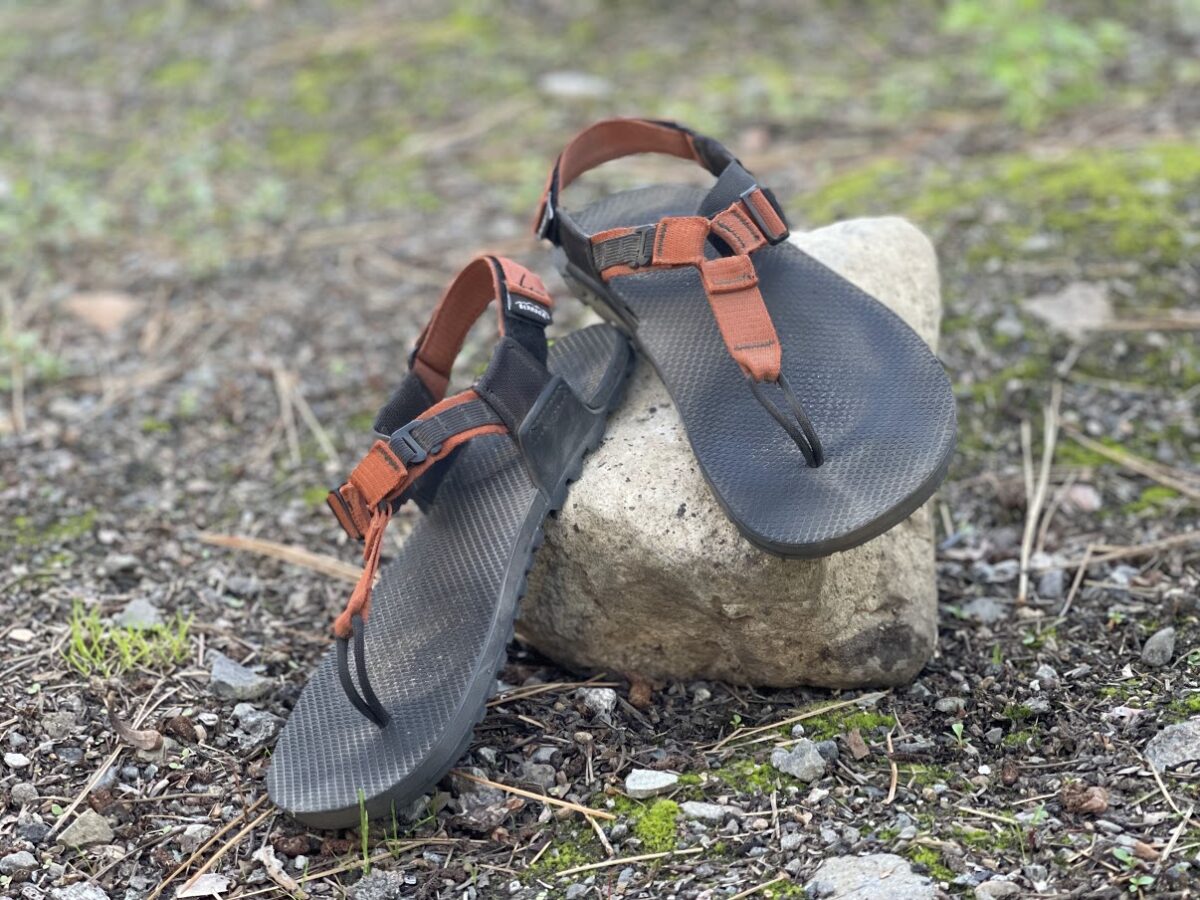
Bedrock Cairn Sandals ($105, 8.5 ounces / 241 g each) are quasi-minimalist hiking sandals with a comfortable and secure webbing system, a precise fit, a durable and grippy Vibram sole, and a between-the-toe design.
I’d heard that Bedrock Sandals were comfortable, well-fitting hiking sandals that felt light but also provided enough mid-sole cushion to protect the feet on 15+ mile (25 km) days. I put these claims to the test in this review, and also discovered some unexpected benefits to the fairly unique webbing system.
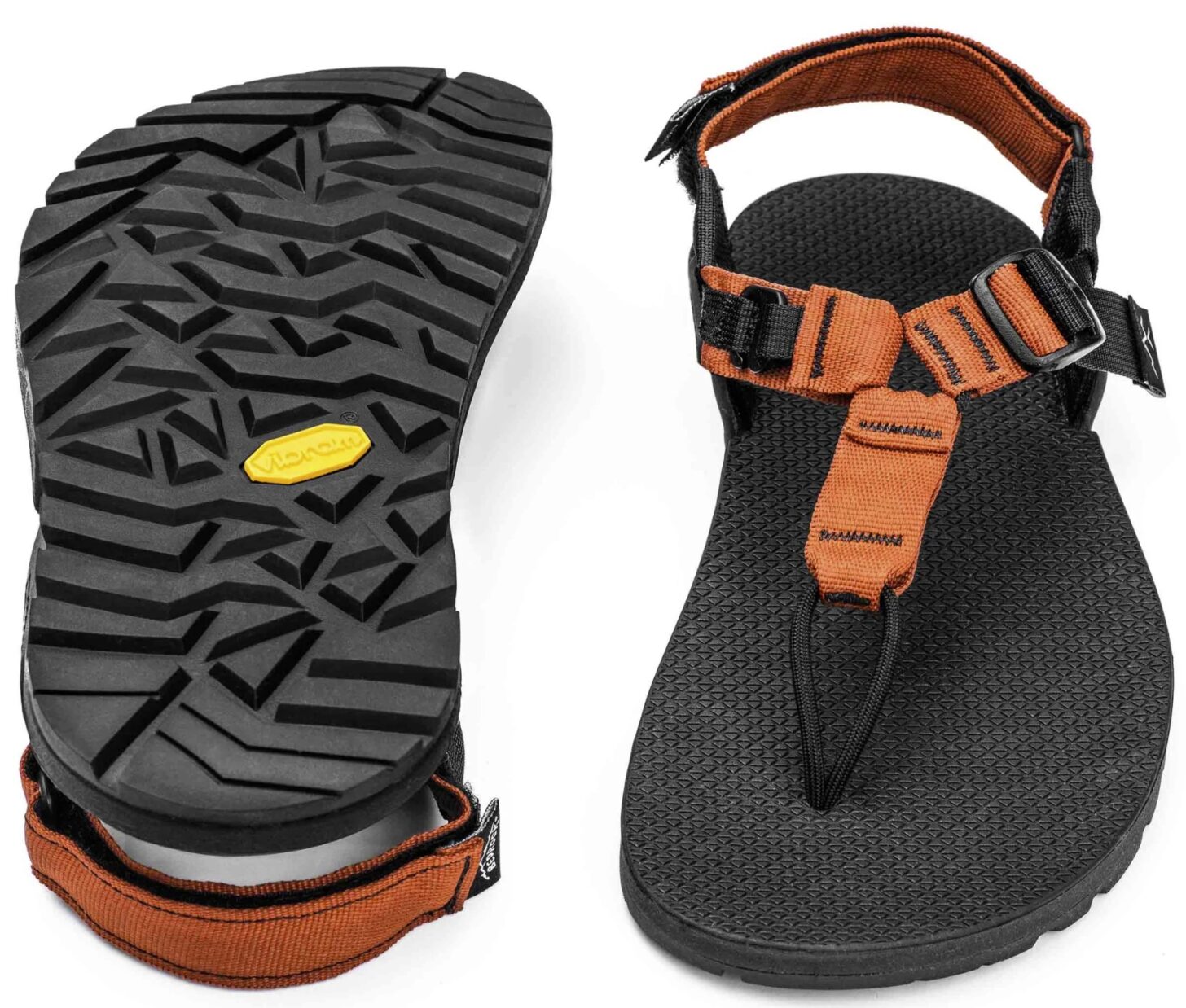
I’ve been hiking in sandals for a long-time, though I’ve embraced the open-toe life in fits and starts over the years. My first experience with backpacking in sandals was while thru-hiking southbound on the Appalachian Trail, when the Merrill trail runners I was wearing completely fell apart after two-hundred miles of mud and rock abrasion in Maine. On the advice of a friend, I bought a pair of classic Chacos at an outfitter in New Hampshire and wore them for about 1,700 miles all the way to North Carolina, where the two feet of snow Superstorm Sandy dumped into the Smokies necessitated a footwear change.
Since then, I’ve hiked in sandals on a thru-hike of the Colorado Trail, over a dozen multi-day backpacking trips, and more day hikes and short overnights than I can remember. My experience with hiking sandal styles runs the gamut from maximalist options like Chacos, through medium-cushion models like Tevas, and on down to ultra-minimalist styles like those from Xero Shoes.
Hiking in sandals – Pros and Cons
Sandals have advantages and drawbacks as compared to the most common type of ultralight backpacking footwear – trail runners. It’s worth examining these pros and cons now so that later in the review we can judge the Bedrock Sandals Cairn Adventure Sandals on their merits as sandals vs. focusing entirely on comparing them to trail runners (though we’ll do a bit of that too).
Pros
Blisters arise from moisture and abrasive material (dust and dirt) trapped within a footwear system. My feet in particular are prone to blisters in two scenarios:
hot, humid environments with lots of mud and rain and hot, dry environments with little shade and lots of very fine, sandy dust
Many backpackers find a simple switch from traditional boots and hiking shoes to flexible, relatively breathable trail runners enough to alleviate classic blister issues in these scenarios. Not so for me. I’ve tried it all – dozens of combinations of socks, balms, creams, and trail runners. So far the best system I’ve found for my feet is lightweight, relatively open-knit merino wool socks paired with zero-drop, wide-toebox shoes, and regular (almost hourly) application of Footglide – and this system is only blister-free about half the time.
Hiking sandals almost entirely remove the issue of trapped moisture (you can get a little moisture between the bottom of your foot and the rubber of a sandal footbed). Without the humid ecosystem of socks and shoes, the dirt picked up on the feet is much less likely to cause blisters. There’s no toe compression or rubbing, no laces to come untied, and no gaiters to fuss with.
Sandal wearers can splash through puddles with impunity, secure in the knowledge that even if it rains all day, they will not be sliding into clammy wet socks and half-dry trail runners the next morning.
Finally, sandals tend to be pretty durable. There’s no mesh to tear and no fabric seems to bust. And many sandals, Bedrock Sandals included, are resoleable – which feels good.
Cons
If sandals were a perfect ultralight backpacking footwear solution, everyone would be wearing them. They are not, and people aren’t. The most obvious problems are related to temperature and exposure to the regular hazards of the trail – abrasive sticks and rocks, insects, sun exposure, and so on. Sandals are obviously not well-suited for snow or frigid temperatures, though I’ve worn them successfully (without socks) in 50 °F (10 °C) daytime hiking temperatures. Using sandals in the proper scenarios – and with a certain degree of acceptance of the negatives in exchange for the positives – is helpful.
There are other, less obvious issues. One frequent problem is that small sticks and pebbles can sometimes get kicked up by footsteps and lodge between the foot and the footbed. Stepping through particularly silty puddles can also create this effect. It’s easy enough to stop and remove such obstructions, but it can mess up hiking rhythm, which is annoying. I’ve found the design of hiking sandals is a huge factor in how often this problem occurs. I’ll get into that further on in the review.
Another problem is that dry conditions can cause heels to crack. Heavily calloused feet are especially prone to this.
Some sandal designs have webbing and tensioning systems that put pressure on delicate areas of the feet, such as across the top of the phalange/metatarsal joints or the back of the Achilles tendon. And some sandals have poorly designed webbing patterns that cause abrasion where the webbing touches the skin. Some people’s feet don’t react well to contact with the hard rubber of sandal footbeds, and blisters on the bottom of the footpads are not unknown.
Many of the issues I just listed can be ameliorated by: 1. Proper sandal choice and, 2. muscle, bone, tendon, and skin adaptation via incremental increases in mileage.
Some people use socks to address these issues as well. I’m not a fan of this strategy because it adds complication and potential moisture back into the system, but many sandal hikers swear by a sock/sandal combo. Your mileage may vary.
Finally, while there are some sandals with deep, highly sculpted footbeds (i.e., Chacos) many sandal designs tend to lean towards the minimalist end of the spectrum. The conventional ultralight wisdom is that there is such a thing as too minimal of footwear, while backpacking (long miles under load). I don’t necessarily disagree with this, but I’ve personally had a lot of success backpacking in ultraminimalist shoes with little-to-no midsole cushioning. I enjoy the freedom, ground feedback, and featherlight sensation such footwear provides, and I’m willing to accept occasionally achy feet as a worthwhile tradeoff. But I’ve reached that point through many years of incremental foot adaptation and training. And of course, having the lightest possible pack helps as well.
Features and Specifications
- weight: 8.5 ounces (241 g) per size nine sandal
- stack height: 14 mm
- outsole rubber: Vibram XS Trek Regolith
- lug depth: 3.5 mm
- three possible adjustment points – 1 g-hook, 1 hook and loop strap, one webbing cinch
- 3/4 inch (2 cm) wide straps
- can be resoled
- USA assembled of domestic and foreign parts
- 1% of every purchase goes to environmental non-profit
Fit And Specifications
I tested the Bedrock Sandals Cairn Adventure Sandals on multi-day backpacking trips, day hikes, and trail runs in the Sierra Nevada. I conducted my testing in the spring and early summer of 2022 on established trails.
My loads were never more than 30 pounds (14 kg) and were often less. My longest testing day backpacking was 20 miles (32 km). My longest testing day trail running was 8 miles (13 km). Trail conditions were mostly dry hardpack with a layer of loose gravel and dust on top, with two instances of wet, puddled trails and slippery rocks due to all-day rain.
PERFORMANCE ANALYSIS. I judged the performance of the Bedrock Sandals Cairn Adventure Sandals on the basis of:
Webbing/strap system. As I mentioned towards the top of this article, I’ve been backpacking, hiking, and running in sandals for just over ten years now, and the Bedrock Sandals Cairn Adventure Sandals have the most secure, comfortable, well-fitting strap system I’ve ever used. I’m not alone in this opinion – in researching for this review, the fit of these sandals is the most remarked upon feature in comments and forums.
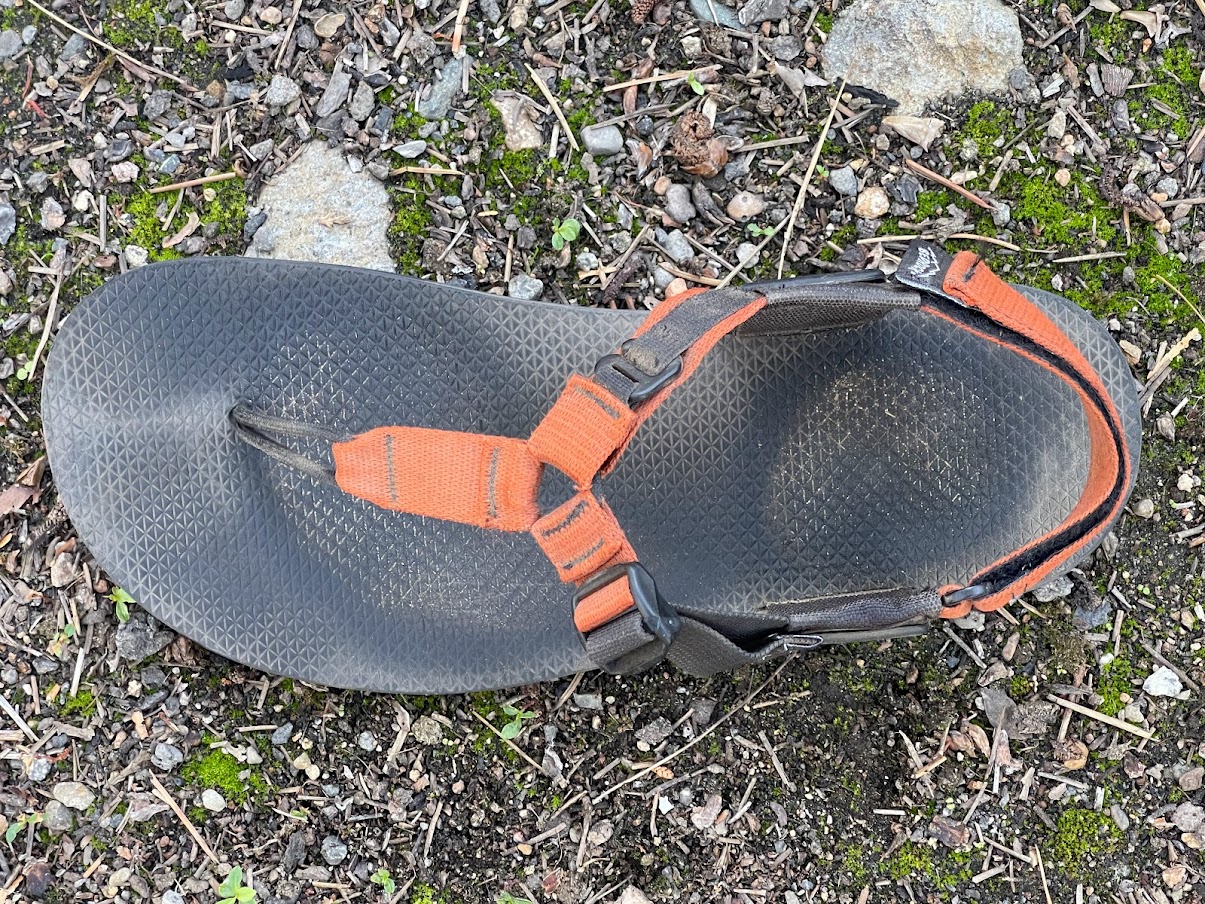
The system works like this:
- A nylon loop runs from the footbed, up between the big and second toe, and connects with webbing just at the base of the toes.
- That webbing runs up to a t-intersection with two other webbing straps, both of which connect to wings on the side of the sandals right at the back of the foot arch.
- Both of these straps are adjustable, although only one needs to be adjusted on a regular basis (to get the sandals on and off and to make minor tension adjustments on the fly).
- A hook-and-loop strap runs around the back of the heel from wing to wing.
- The tightening of the hook and loop strap moves the foot forward on the footbed, and loosening it allows the foot to slide further back towards the rear of the footbed.
- Cinching the right-hand strap secures the webbing in place around the base of the ankle, which creates a fit that is secure while also being comfortable.
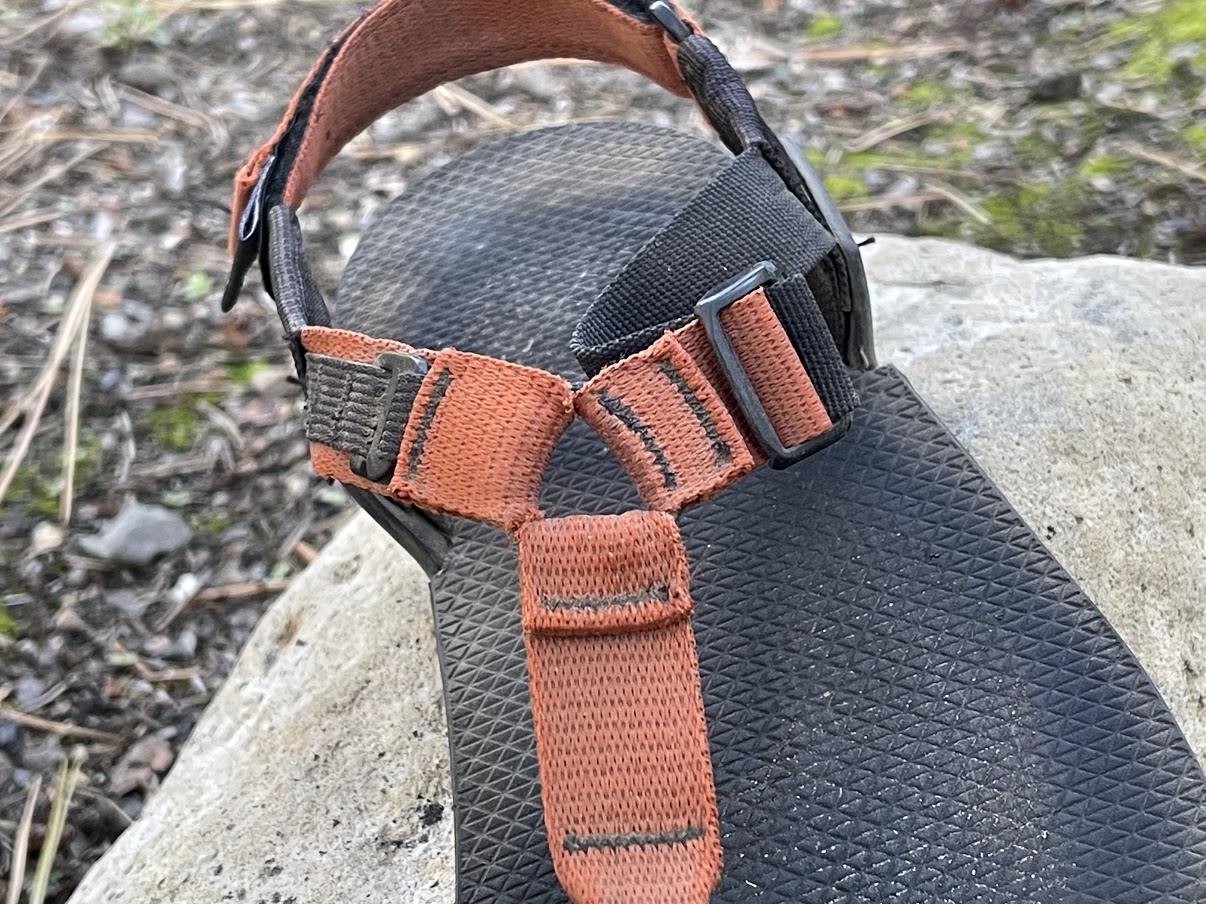
This system is quite different than that used by most other hiking sandals. For more on this, see my commentary section.
Weight. The Bedrock Sandals Cairn Adventure Sandals weigh about 8.5 ounces (241 g) each for a men’s size nine. That puts them at about 1 ounce (28 g) lighter than a comparable size in my current favorite zero-drop, wide-toebox trail runners, the Inov8 TRAILFLY G 270s (formerly TERRAULTRA G 270s). And they are 2 ounces (57 grams) lighter than comparably sized Altra Lone Peak 6s.
How does this weight stack up to other popular hiking sandals? Let’s take a look.
Table Notes: All weights reflect men’s size nine. Many of the brands featured here have more than one sandal type. I tried to choose models that are either go-to choices for sandal hikers (Chaco Z1/Classic) or are middle-of-the-road options as identified by the brand.
| Bedrock Sandals Cairn Adventure Sandals | 8.5 ounces (241 g) |
| Chaco Z1/Classic | 14.9 ounces (422 g) |
| Teva TERRA FI 5 Universal | 14.3 ounces (403 g) |
| Luna Middle Bear Winged Edition | 8.2 ounces (232 g) |
| Xero Shoes Z-Trail EV | 5.4 ounches (153 g) |
The Bedrock Sandals Cairn Adventure Sandals sit smack in the middle of the weight table, totally outclassing the (thicker, more classically supportive) Chaco and Teva options. Cairns are roughly even with the modal from Luna that I chose, and that makes sense as they seem to share a design philosophy and midsole thickness. Look at how similar their profiles are.


Xero Shoes is known for its minimal footwear offerings, so it’s perhaps no surprise that their Z-Trail EV is only 5.4 ounces (153 g). That weight comes with less cushioning in the midsole, however.
In short, Bedrock Sandals seems to have found a bit of a middle ground with the Cairns. They certainly felt light enough on my feet, and I’ve spent the last few years in minimalist footwear of all types. Weight also ties into issues like ground feel, foot comfort and pain, and durability, so we’ll move into those issues next.
Midsole/Outsole. Bedrock Sandals Cairn Adventure Sandals have a stack height of 14 mm, which again places them pretty much in the middle of the hiking sandal family in terms of thickness (and also contributes to their middle-of-the-road weight). I found this stack height plenty thick enough to protect from stone bruises. Backpackers with loads over 30 pounds (14 kg) might feel some foot pain around the end of the day; I started to get achy feet about mile twenty, which is pretty normal for me no matter what type of shoes I’m wearing.
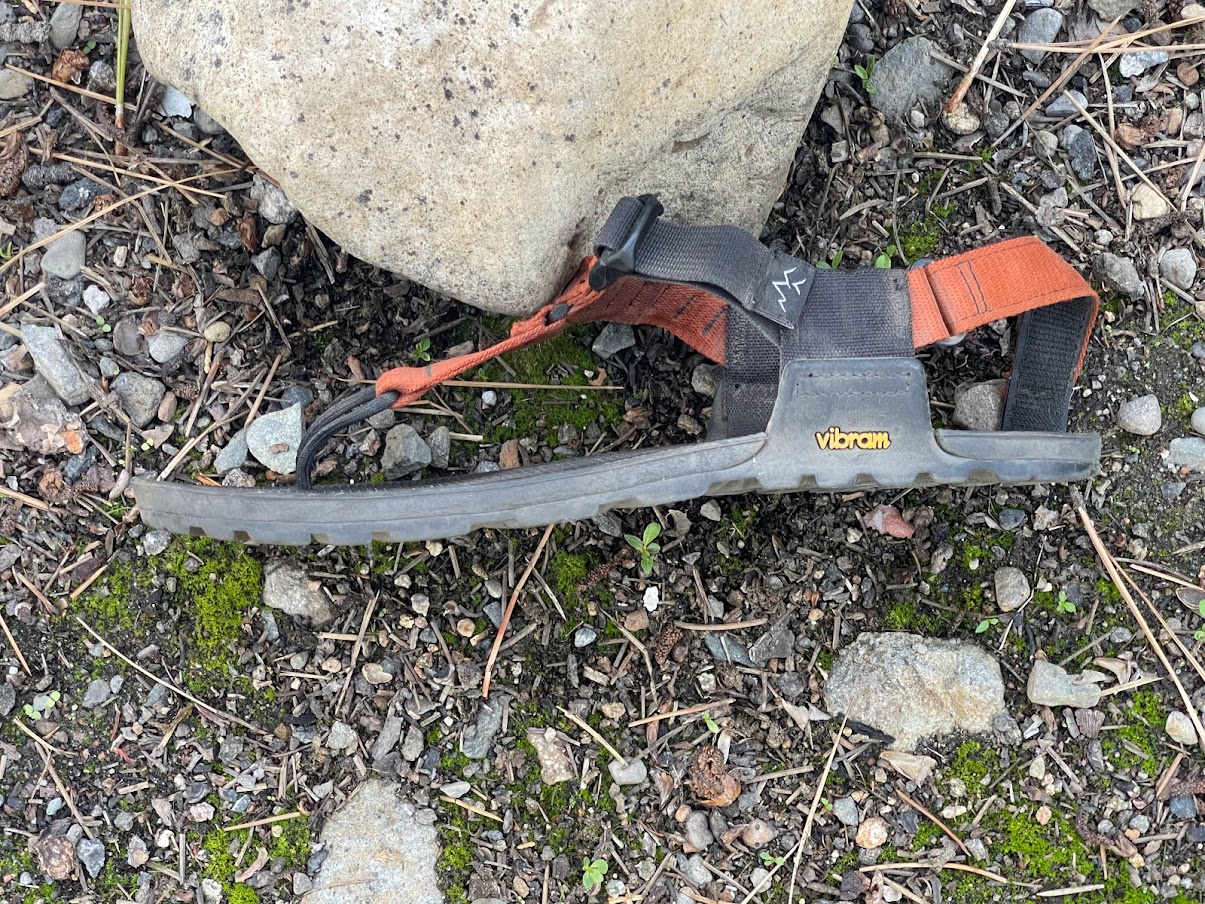
Bedrock Sandals chose a Vibram XS Trek rubber with 3.5 mm lugs for the outsole of the Cairns. Vibram says XS Trek is a good middle-ground between grippy and hard-wearing. After testing on loose soil, stone, and in wet, muddy conditions, I tend to agree. The tread pattern Bedrock chose isn’t my favorite in the hiking sandal family (that honor goes to the Luna Bear Winged Edition) but it’s far from my least favorite.
I’d rank the combination of rubber and tread pattern near the top of class in dry conditions and middle-of-the-road for slippery rocks and mud. Bedrock Sandals offers a stickier but presumably less durable rubber on the Cairn PRO II Adventure Sandals . I’m planning on testing those on my next trip on muddy Appalachian paths.
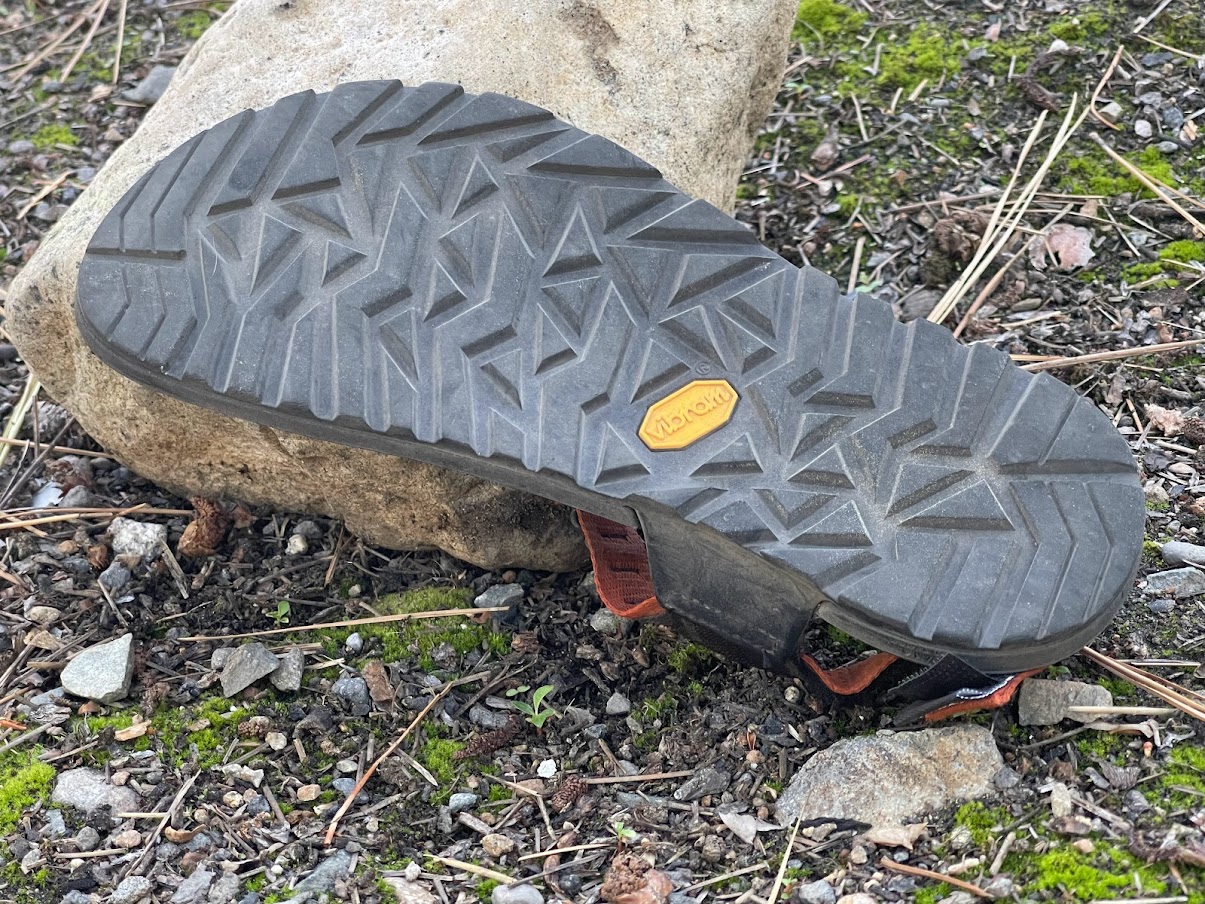
Footbed. The Cairns are zero-drop and have a middling-to-narrow footbed. Bedrock Sandals utilizes a clever printable sizing system that allows you to place your foot on an outline of your suspected size to see just how things line up before you purchase.
Cairns are available in two footbed styles – flat and sculpted. I opted for flat because I wanted to test my theory that sculpted sandal footbeds trap more twigs and rocks than flat footbeds. And indeed, in my testing, I had to stop and fish out debris far less than I did when wearing sandals with sculpted footbeds. This could also be a factor of the Cairns secure tensioning system.
COMMENTARY
What makes Bedrock Sandals Cairn Adventure Sandals Unique? As compared to many other sandal brands, the chief things of note here are:
- There are four separate webbing straps, none of which run through the sole. Continous webbing is a feature of many hiking sandals that supposedly allows for a dialed-in fit, but in practice, I find it hard to adjust, susceptible to fit creep in wet conditions, and difficult to get comfortable in the first place, with some section of the webbing always being too tight or too loose.
- When the primary tightening strap is tensioned, the force is applied around the front, across the transitional bones between the ankle and the metatarsals.
- The toe thong and heel strap mostly keep the front and back of the sandal from flapping around. Designs like those used by Teva, Chaco, and Xero Shoes put pressure around the back of the ankle over the Achilles tendon, at the base of the toe joints, and across the top of the metatarsals.
I’m not a doctor. And I have put in over 2,000 successful miles (3219 km) in sandals of the Chaco/Teva/Xero Shoes webbing design. But I’ve also experienced some foot pain and repetitive use injury.
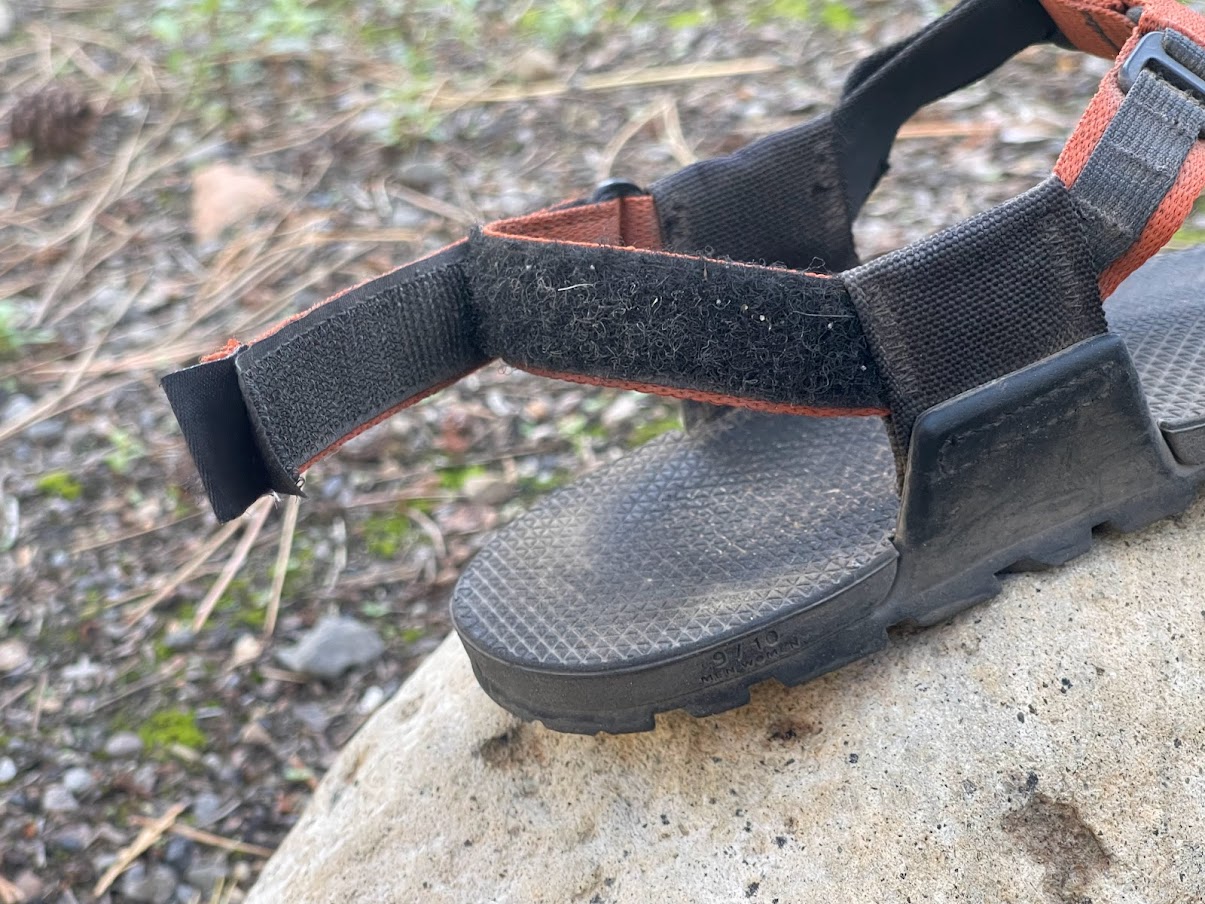
Looking at foot anatomy and comparing that to where I have felt sandal-related pain in the past (Achilles tendon, metatarsals, metatarsal/proximal phalange joints) I can make an inference about what is causing that pain. If I was thru-hiking in sandals (and I fully plan to do so again) I would choose a sandal with a webbing design of the Bedrock Sandals type. For what it’s worth, Luna Sandals also utilizes a variation of this design, and I’m sure there are others out there as well.
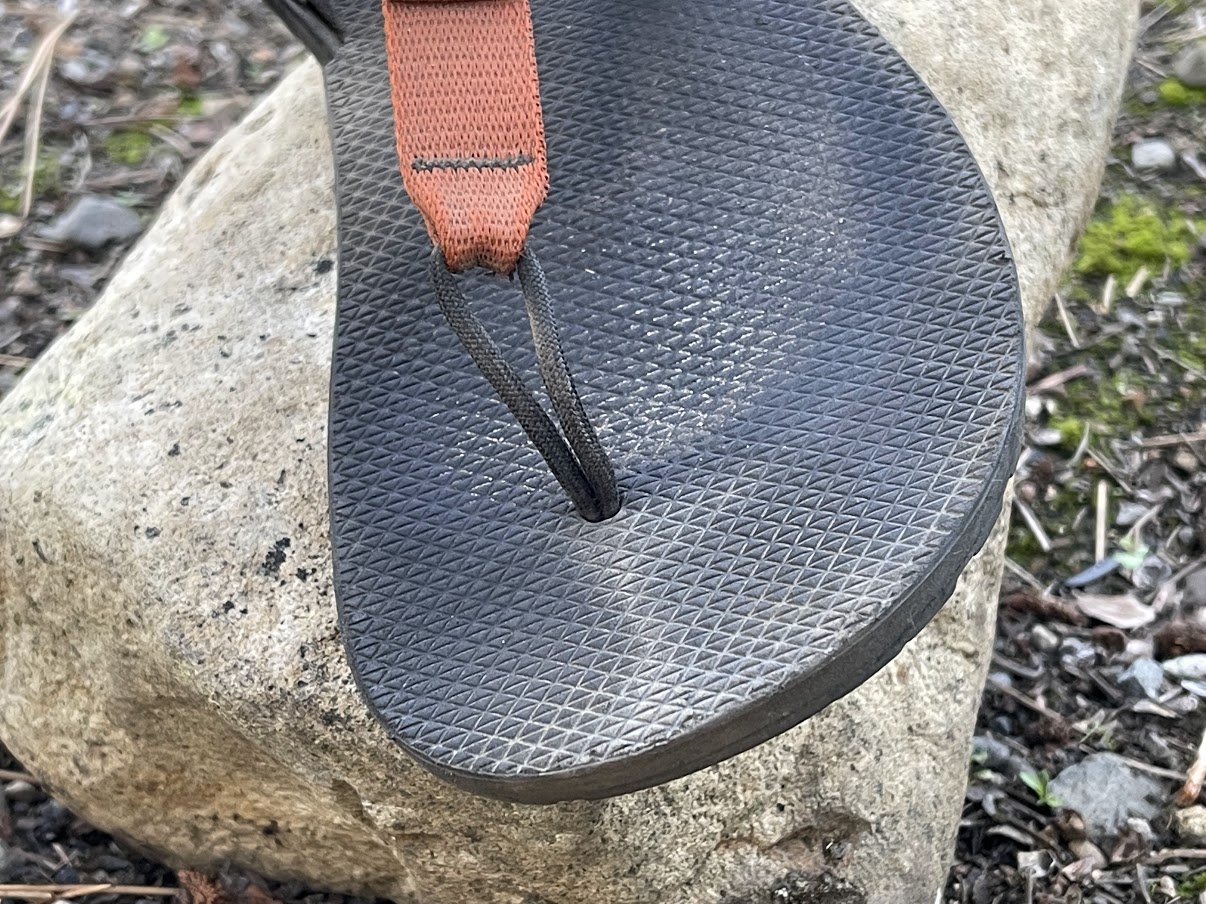
Bedrock Sandals Cairn Adventure Sandals Compared to Chaco Z/1 Classics
Additionally, though I have tried many types of hiking sandals and have increasingly moved towards minimalist styles, I still have the most miles by far in Chaco Z/1 Classics. Finally, Chacos have a huge market share and brand recognition, are widely available, and have a bit of a mythos (search Chaco tan online). I believe they are still the hiking sandal most likely to be recommended by your average gear shop employee.
Weight. Bedrock Sandals Cairn Adventure Sandals weigh half as much as Chaco Z/1 classics. There is no competition here. Edge:Bedrock Sandals Cairn Adventure sandals
Price. Cairn Adventure Sandals are five bucks more expensive than classic Chaco Z/1s. Edge: Chacos, barely.
Tensioning System. Chaco Z/1s have a “continuous” webbing system that runs through the sole of the sandal and is hard to tension precisely, especially when grit and dirt clog the areas where the webbing enters the midsole. The rear webbing strap is not adjustable, and the webbing straps run over top of delicate areas of the foot.
Bedrock Sandals Cairn Adventure Sandals utilize a four-piece, highly adjustable webbing system with tension force around the upper foot/lower ankle as opposed to the delicate bones of the feet.
Edge:Bedrock Sandals Cairn Adventure Sandals by a mile.
Footbed/Midsole. The classic Chaco footbed has remained unchanged for decades, and it has a lot of die-hard fans. Personally, I’m no longer convinced the weight tradeoff (and resulting energy expenditure) is worth the extra cushioning and support. But adapting to minimalist-style footbeds requires time and patience. Furthermore, a dialed-in kit on your back is crucial for backpacking with minimalist shoes. I’m willing to believe there are users who will find the Chaco footbed and midsole more useful. Edge: Tie, use-case and user-dependent.
Outsole. It appears that Chaco has changed the tread pattern on the Z/1 Classic since I last put some miles on some. But looking at photos of the newest version, I’m still seeing some channels that run along the vertical (toe to heel) axis of the sole. I’m not a fan of that pattern, as I tend to think it leads to slippage in dusty, loose soil. I much prefer the angular, geometric pattern on the Cairn Adventures. Both sandals have a lug depth of 3.5 mm. Edge:Bedrock Sandals Cairn Adventure Sandals
Strengths
- comfortable and secure tensioning system
- strikes a middle ground among hiking sandals for weight and stack height
- rubber and tread pattern performs very well in dry conditions and well enough in wet conditions
- minimalist-style flat footbed
- can be resoled
Limitations. Packrafters, canoeists doing portage, and hikers in extremely wet and muddy conditions might want to consider a sandal with a softer, more grippy outsole rubber, such as the Cairn PRO II Adventure Sandals
- hikers with +30 pound (480 kg) loads or sensitive knees and feet might want a sandal with a thicker, more supportive footbed
Where to Buy You can buy Bedrock Sandals Cairn Adventure Sandals on the Bedrock Sandals website and at REI
